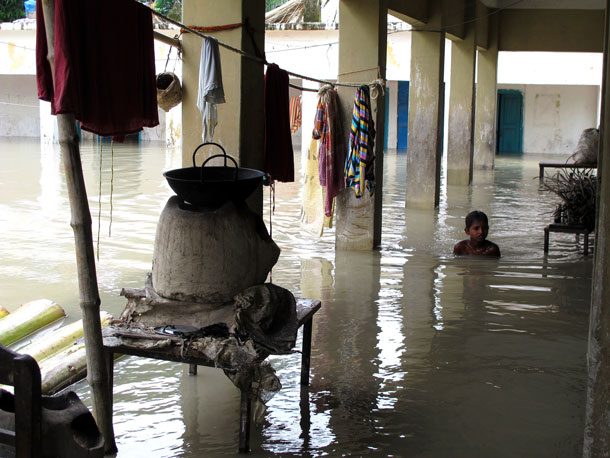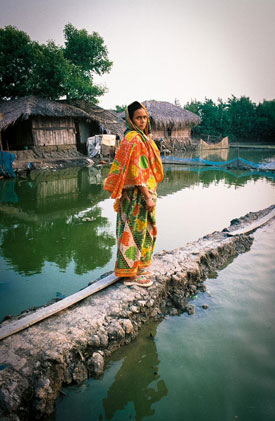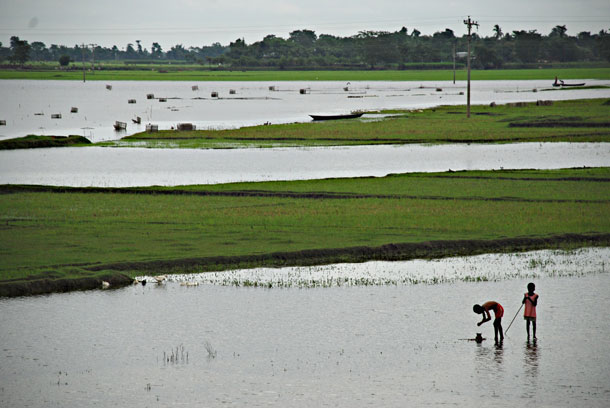Bangladesh’s Climate Migration Crisis
Air Date: Week of February 8, 2019

Flooding is a major issue in Bangladesh that affects thousands of people’s lives. (Photo: Flickr, Climate Centre CC BY-NC 2.0)
In Bangladesh, hundreds of thousands of people are being displaced from their coastal homes, and are moving into the slums of cities underprepared to handle this crisis. Journalist and 2018 National Geographic Explorer Tim McDonnell talks with host Steve Curwood about the climate migration crisis in Bangladesh.
Transcript
CURWOOD: Climate disruption already has millions of people on the move
forcing entire communities from their homes. And perhaps no population is more imperiled than the people of Bangladesh. Nearly 80 percent of Bangladesh sits in a flood plain, near the rising seas. More frequent strong storms have meant even more flooding and saltwater intrusion for a country that is already routinely flooded during the monsoon season. National Geographic writer Tim McDonnell recently traveled to Bangladesh and joins us now from Washington D.C. Thanks for joining us, Tim!
MCDONNELL: Great to be here, Steve. Thank you so much.
CURWOOD: Tim, what exactly is happening in Bangladesh that's leading to this climate migrant crisis for people living along the coast?
MCDONNELL: So, Bangladesh is one of the world's most vulnerable countries to climate change. And, it's experiencing a pretty wide range of different impacts everything from riverbank erosion that is increasing because of ice melting in the Himalayas, that's coming down through rivers in Bangladesh, increasing the volume of water there and leading to erosion. They have, of course, tropical storms and cyclones that affect people. They have regular flooding. They have an increase in saltwater intrusion in the coastal areas because of sea level rise, that's poisoning crops and fishing areas there. And, in fact, in the north of the country, they also experience drought. So they really get all of these different impacts. Bangladesh, being a very densely populated country, a lot of the times these impacts lead to people being displaced in one way or another
CURWOOD: As I understand it a lot of people who have been affected by this climate disruption are moving into Dhaka that's the capital city of Bangladesh. But, you report that they're not exactly finding solace instead they're getting stuck in slums and working in difficult hard labor jobs. Just how well is Dhaka doing at receiving this inundation of people and what are they doing to adjust to this population increase?
MCDONNELL: Well, Dhaka is really I think out of its depth. And I spoke to everyone from 'course migrants themselves to scientists, urban planners, really a broad range of different people who are involved in this space. And there was pretty much universal agreement that the city is beyond its capacity. They have thousands of people arriving there every day. Not all of those are climate change migrants, of course, but many of them are. And actually, 40% of the city's population lives in slum areas. You know, the city really has very little in the way of affordable housing. It's really not prepared for this influx at all. And so people are kind of finding housing anywhere that they can. On the fringes of construction sites, in the kind of backyards of skyscrapers. I visited one slum community that the land had actually been built from scratch over what used to be a lagoon. People had filled in a lagoon with sand and then kind of built a new community on top of that. So, you know, people are really just kind of looking for any place that they can stay. But it's it's happening all in a very kind of helter-skelter, unplanned sort of way that creates a lot of problems for people living there. They have a problem with human trafficking. So it's kind of security, health, utilities, basic living conditions, all of these things are really negatively affected when you have so many people coming in, in such a kind of unplanned way.
CURWOOD: And, we should mention that this is a bit of a perfect storm, because along with the climate disruption, there are all these folks who are being forced to flee out of Burma if they are from the Rohingya group. And I imagine that's had a huge impact as well.
MCDONNELL: Definitely. And what's really interesting about that crisis to is that it's sort of a double crisis. You have refugees who are fleeing into Bangladesh, because of that Rohingya crisis. They're finding relative, you know, kind of safety in Bangladesh, but then also moving into areas that are again, highly exposed to climate change, mudslides, flooding, that sort of thing is really a problem for those Rohingya refugee settlements. And that's something that I think is something that really needs to be looked at closely all around the world, is not only how climate change is prompting migration or prompting refugee crises, but is creating additional problems for, you know, migrants or refugees who maybe move because of violence or other forms of persecution. They may be exposed to climate change impacts in the place where they arrive. And certainly, that is happening in Bangladesh.

Forida Khatun stands behind her house in Gabura, Bangladesh, in November. Two of her sons migrated to Dhaka after the family home was destroyed by storms multiple times and agricultural jobs were lost due to salinity intrusion. “Only Allah can save us," she says. "We don’t have any power to save our children.” (Photo: Tim McDonnell)
CURWOOD: So, there are monsoons there in South Asia, it's nothing new to Bangladesh. People there time and time again, survive sometimes horrific monsoons and rebuild. What's changed what's different now?
MCDONNELL: There's a few things that are different. In some cases, the impacts that people are experiencing are new. For example, this kind of saltwater intrusion that I mentioned. Because of sea level rise, salt water coming into coastal areas that are really predominantly agricultural. People have fish farms and rice paddies there and salt water has had a huge impact on people's ability to grow crops and fish in that area. And there was a study that actually just came out in November, indicating that in the next few decades, hundreds of thousands of people could be displaced just because of that salt water impact alone. So, that's a kind of new impact. In other cases, as you mentioned, some of these impacts are things that people who have been living in this Ganges River Delta have been dealing with for 10s of thousands of years. Riverbank erosion is nothing new. Tropical storms are not new. You mentioned the monsoons, of course, not new. But it's really the rate that these things are happening and the kind of scale of impact. And, also, one thing that climate change does is it tends to disrupt the rainfall patterns, the seasonal rainfall patterns. So, you're getting rain at times, when you don't expect it, you're not getting rain at times when you think that it should be coming. So it's really throwing off the course of the monsoon, sometimes strengthening the monsoon. So it's just kind of throwing a wrench in all of the works of these natural cycles that people are used to. And then, of course, in the background of that, you have really high rates of population growth. So at the same time that these environmental catastrophes are happening, you just have more people who are exposed to the challenge. And that leads to an increase in the level of displacement.
CURWOOD: So, if the weather systems are messed up, how are people eating? How are people able to grow the food they need?
MCDONNELL: One thing that you see in the coastal regions that I visited was people switching rice paddies over to shrimp farming, which tends to be a little bit more tolerant of the salt. So, people kind of are experimenting with different ways of growing crops, I met a few farmers who are experimenting with trying to grow salt-tolerant rice. So, there's a kind of science and adaptation element here where people are looking for new opportunities, you know, trying to kind of fill in where they can. One of the problems with shrimp farming, interestingly, is that it's more tolerant to salt, but it employs far fewer people. You could have one shrimp farm that, you know, the same area, if you are growing rice, you could maybe employ 100 people. For shrimp farm, you're just employing one or two, it's very kind of low maintenance. And, again, so that's where you start to see these climate impacts bleed over into economic impacts. And it starts to kind of blur the line between people who are climate refugees or disaster refugees and economic migrants.

Due to saltwater intrusion, many farmers in Bangladesh are converting their rice patties into shrimp farms which are more tolerant of salt. (Photo: Flickr, Amir Jina CC BY-NC-ND 2.0)
CURWOOD: How did you feel seeing all this?
MCDONNELL: Well, it was-it was really disturbing. The way that one person described it, kind of local leader in one of the coastal areas that I went to, is that this kind of migration, the loss of people in these coastal communities, what the way he said it is that it leaves a hole in the heart of the village. So people, I think, really feel kind of emotional strain from losing their family members, obviously, and people feeling like they're really kind of starting to lose faith in their ability to maintain a life in this coastal area that they have called home for generations. I mean, no one wants to leave. In all these cases, you know, I didn't meet a single person who said, "I'm really excited to get to go try my luck in Dhaka." This is always a very painful choice for people. But at the same time, I found that people in Bangladesh were really up for trying to adapt the best that they can. One scientist I interviewed said Bangladesh might be one of the world's most vulnerable countries to climate change, but it's also one of the most ready to adapt. People here have been kind of living with environmental catastrophe for generations and generations.
CURWOOD: By the way, how close to sea level are these coastal towns within Bangladesh, and how much has sea level been rising for them?
MCDONNELL: In some places that I went to, I talked to one local leader who told me that in his area the high tide has been coming up by about a foot a year for the last several years. So that's, you know, it's really quite an alarming rate of sea level rise. In the coming decades, you know, you're going to see a lot of area that is just totally submerged. Permanently, year round. So that's just something that people are kind of having to deal with now, is that looking forward to that kind of future.
CURWOOD: Looking ahead, how much of Bangladesh will potentially, well, just become uninhabitable?
MCDONNELL: Yeah, so there was a study that was done that found that because of sea level rise, the land on which more than 800,000 people currently live, is expected to be permanently submerged by the year 2100. So I mean, that just really shows you the level of change that's happening. Hundreds of thousands of people, the land that they're currently living on, is going to just be permanently underwater. And that's really just only, you know, a kind of piece of the pie because you have all these other factors like storms, saltwater intrusion, that are simultaneously displacing other people. You know, it's all of these factors that come together, that's how you get up to this number of more than 13 million, which is what the World Bank prediction for the number of climate migrants in Bangladesh by 2050.
CURWOOD: So, people sometimes say that the Bay of Bengal, where Bangladesh is, is the canary in the coal mine for what the risks that civilization is running with climate disruption. How fair is that?
MCDONNELL: I think that's very true, actually. A country like Bangladesh really encapsulates a wide number of the risks that climate change poses to all different parts of the world. All these things that are prompting kind of human migration. And when you look at Bangladesh, especially, you see what happens when you have this kind of unprecedented level of human mobility. You have this unchecked rampant urbanization that's a problem. You have risk for all sorts of vulnerabilities, health problems, human trafficking, all these other things that people have to face there. And it really encapsulates the challenge that lots of different countries are going to face moving forward. And that's why it's so important now, at this stage for world leaders to become more serious about dealing with this climate change and migration nexus. Figuring out ways to provide safe passage for people. Getting more serious about what this crisis is going to look like and what we can do to try to ease, you know, life for people who are affected by this.
CURWOOD: Tim McDonnell is a journalist and National Geographic Explorer. Thanks for taking the time with us today, Tim.
MCDONNELL: My pleasure, Steve. Thank you so much.
Links
National Geographic | “Climate Change Creates a New Migrant Crisis for Bangladesh”
Living on Earth wants to hear from you!
Living on Earth
62 Calef Highway, Suite 212
Lee, NH 03861
Telephone: 617-287-4121
E-mail: comments@loe.org
Newsletter [Click here]
Donate to Living on Earth!
Living on Earth is an independent media program and relies entirely on contributions from listeners and institutions supporting public service. Please donate now to preserve an independent environmental voice.
NewsletterLiving on Earth offers a weekly delivery of the show's rundown to your mailbox. Sign up for our newsletter today!
 Sailors For The Sea: Be the change you want to sea.
Sailors For The Sea: Be the change you want to sea.
 The Grantham Foundation for the Protection of the Environment: Committed to protecting and improving the health of the global environment.
The Grantham Foundation for the Protection of the Environment: Committed to protecting and improving the health of the global environment.
 Contribute to Living on Earth and receive, as our gift to you, an archival print of one of Mark Seth Lender's extraordinary wildlife photographs. Follow the link to see Mark's current collection of photographs.
Contribute to Living on Earth and receive, as our gift to you, an archival print of one of Mark Seth Lender's extraordinary wildlife photographs. Follow the link to see Mark's current collection of photographs.
 Buy a signed copy of Mark Seth Lender's book Smeagull the Seagull & support Living on Earth
Buy a signed copy of Mark Seth Lender's book Smeagull the Seagull & support Living on Earth

